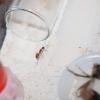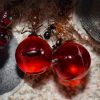Meant to start this back in December but might aswell now.
On December 4th, 2021 Neoponera villosa had one of their Nuptial Flights. I was fortunate enough to be in the area during the flight and was able to observe numerous founding queens running accross the jungle floor.
On December 5th, 2021 I flipped a large dead tree and under it were 4 Neoponera villosa queens attempting to found together. Finding 4 together was a first for me as the highest I have ever found under something was 2 back in April 2019.
In finding the 4 together I was hoping they would have already determined the social hierarchy among themselves by dueling and other submissive behaviors. I collected the 4 queens and proceeded to set them up together in a horizontal nest made by coc for me.
Eggs were laid around a day after collection and did not hatch for ~28 days.
January 3rd, 2022
The eggs hatched into larvae, there are roughly 6 which in my experience is a fairly large first batch, usually it is 1-3. I attribute this to the multiple queens, even though through the hierarchy there is only one dominant egg layer at a time.
Edited by attagarrett, January 5 2022 - 3:12 PM.
















